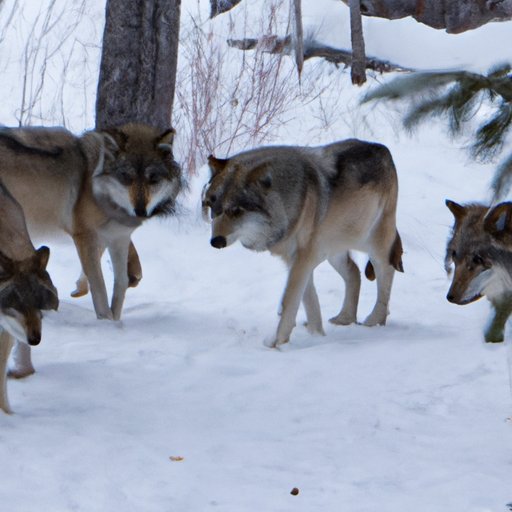Introduction
Wolves are intelligent, social animals that live in packs. As pack animals, they rely on each other for protection and survival. Wolf packs travel together for many reasons, such as searching for food, establishing new territories, and caring for their young. But what exactly is “wolf pack travel” and how do wolves go about it? This article will explore the different aspects of wolf pack travel, from the social hierarchy within the pack to the role of communication and the impact of the environment on the way in which wolves travel.

Examining the Social Hierarchy of Wolf Packs
In wolf packs, there is a distinct social hierarchy. At the top of the hierarchy are the alpha wolves, who are typically the largest and strongest members of the pack. They are the leaders of the pack and they make all the decisions. Below the alphas are the beta wolves, who are second in command. The betas help the alpha wolves to enforce the rules of the pack and keep everyone in line. At the bottom of the hierarchy are the omega wolves, who are usually the youngest and weakest members of the pack. The omegas often have to perform the most menial tasks, such as cleaning up after the other wolves.

How Wolves Use Coordinated Movement to Travel in Groups
When wolves travel in a pack, they use coordinated movement to stay close together and move in the same direction. In order to stay close together, the wolves will often engage in behaviors such as following one another, walking side by side, and forming a circle around a leader. This helps them to stay connected and maintain contact with one another. To establish a common direction, the alpha wolves will lead the way, while the other wolves follow behind. This allows the pack to move together more efficiently and effectively.

The Benefits of Traveling in a Pack for Wolves
Traveling in a pack has many benefits for wolves. For starters, it increases their vigilance and safety. When wolves travel in a group, they can watch out for potential threats and alert each other to danger. Additionally, traveling in a pack allows wolves to share resources. If one wolf finds or kills food, the others can benefit from it as well. This ensures that everyone in the pack gets enough to eat and keeps the pack healthy and strong.
Exploring the Division of Labor in Wolf Packs
In wolf packs, there is a division of labor between the members. The alpha wolves are typically responsible for leading the pack and making important decisions. The beta wolves help to enforce the rules of the pack and keep everyone in line. The omega wolves often have to perform the most menial tasks, such as cleaning up after the other wolves. Additionally, all members of the pack are expected to participate in hunting and helping to care for the young.

Investigating the Role of Leadership in Wolf Pack Travel
Leadership plays an important role in wolf pack travel. Alpha wolves are usually the ones who take the lead and set the direction for the pack. Other wolves will then follow their lead, allowing the pack to move together in a coordinated manner. Additionally, alpha wolves can use body language and vocalizations to indicate where the pack should go and when it should stop.
Understanding the Role of Communication in Wolf Pack Travel
Communication is essential for wolf pack travel. Wolves use vocalizations such as howling to communicate with one another and to let other packs know where they are. Additionally, they use body language to express their feelings and intentions. For example, wolves may stand tall and raise their tails to assert dominance, or they may crouch down and flatten their ears to show submission.
Analyzing the Impact of Environment on Wolf Pack Travel
The environment can also have an impact on wolf pack travel. For instance, if there is an abundance of prey in the area, wolves may travel in larger groups in order to take advantage of the available resources. On the other hand, if there is a shortage of prey, wolves may travel in smaller groups in order to conserve energy. Additionally, the terrain can affect the way in which wolves travel. If the terrain is difficult to traverse, the pack may need to slow down or take alternate routes in order to reach their destination safely.
Conclusion
This article has explored how wolves travel in a pack, discussing the social hierarchy, coordinated movement, division of labor, leadership, and communication among wolves. It also examined the impact of the environment on the way in which wolves travel. By understanding these aspects of wolf pack travel, we can gain insight into the behavior and dynamics of this fascinating species. Further research is needed to better understand how wolves travel in a pack and the implications of this behavior on their survival.
(Note: Is this article not meeting your expectations? Do you have knowledge or insights to share? Unlock new opportunities and expand your reach by joining our authors team. Click Registration to join us and share your expertise with our readers.)
